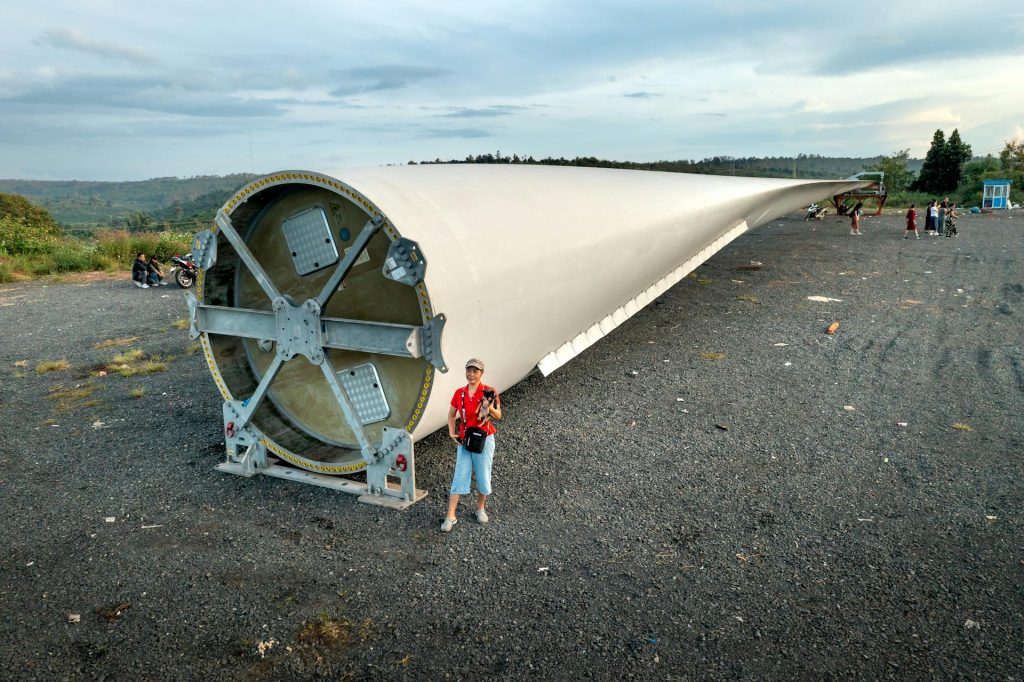Recycling Wind Turbines: The $20B Industry Nobody’s Talking About
Introduction: The Hidden Crisis—and Opportunity—of Wind Turbine Waste

In the rolling hills of Sweetwater, Texas, a farmer named Carl Johnson stares at a 120-foot wind turbine blade lying in his field. “They told me it’d be here 20 years,” he says. “Now they’re saying it’ll take 400 to decompose. What am I supposed to do with this?”
Carl’s dilemma isn’t unique. Over 720,000 tons of wind turbine blades will reach end-of-life by 2025, creating a global waste crisis. Buried in landfills or incinerated, these fiberglass behemoths release toxic fumes and occupy space for centuries. But a quiet revolution is brewing: startups are transforming this “green waste” into high-value products like bridges, e-bikes, and designer furniture.
The global wind turbine recycling market is projected to hit $21.8 billion by 2030, yet remains overlooked by mainstream climate discourse. This article explores the innovators, policies, and technologies driving this circular economy gold rush—and why 2025 is the tipping point.
Why Wind Turbine Recycling Matters in 2025
1. Sheer Volume: A Tsunami of Blade Waste
By 2025, over 50,000 blades will be decommissioned annually—enough to stretch from New York to Los Angeles if laid end-to-end. The U.S. alone will account for 15,000+ blades yearly, many piling up in rural landfills.
“We’re solving today’s climate solution with tomorrow’s environmental disaster,” warns Dr. Rebecca Carter, a materials scientist at MIT.
2. Regulatory Pressure: The EU Leads, the U.S. Lags
- EU: A 2026 landfill ban forces companies to recycle or repurpose blades.
- U.S.: No federal mandates exist, but states like Texas and Iowa offer tax incentives for recycling plants.
- Asia: China’s “Green Great Wall” initiative includes blade recycling pilot programs.
3. Economic Potential: Turning Trash into Cash
Recycled blade materials can slash manufacturing costs by 40% (Global Fiberglass Solutions). For example:
- Composite lumber from blades costs 1.20/lbvs.1.20/lbvs.3.50/lb for virgin materials.
- Upcycled blade furniture sells for 200% markup due to its “eco-luxury” appeal.
The Innovators: Startups Turning Blades into Gold
1. Global Fiberglass Solutions (U.S.): Building Bridges, Literally
Founded in 2009 by Don Lilly, a former Boeing engineer, GFS shreds blades into raw fibers for construction materials.
- Flagship Project: A pedestrian bridge in Baltimore made entirely from recycled blades.
- Impact: Diverted 12,000+ tons of waste since 2020.
- Quote: “We’re using the skeletons of the green revolution to build the future.”
2. Carbon Rivers (U.S.): The Science of Second Lives
This Knoxville-based startup uses pyrolysis—a process that heats blades to 1,000°F without oxygen—to extract reusable glass fibers.
- Output: Fibers sold to Ford for lightweight car parts.
- 2025 Goal: Recycle 100 blades/month.
3. BladeBridge (Belgium): From Wind Farms to Bike Lanes
Architect Lars Ostenfeld turned shredded blades into functional art:
- Cork Bike Bridge: A 25-meter structure in Ireland supporting 30-ton trucks.
- Public Art: Blade sculptures in Rotterdam’s harbor district.
4. Re-Wind (Global Consortium): Power Lines from Blades
This academic-industry partnership repurposes blades as:
- Power line poles in rural Georgia.
- Noise barriers along German highways.
Recycling Methods Compared
| Method | Process | Pros | Cons | Startups Using It |
|---|---|---|---|---|
| Mechanical | Shredding blades into raw fibers | Low cost, scalable | Limited to low-value products | Global Fiberglass Solutions |
| Thermal | Pyrolysis (heating without O2) | High-purity fibers for aerospace | Energy-intensive; $500K+ setup | Carbon Rivers |
| Chemical | Solvents break down resins | Preserves 95% fiber strength | Slow; $1M+ R&D costs | Siemens Gamesa (R&D phase) |
Policy Gaps: Where Governments Are Falling Short
1. EU vs. U.S. Approaches
- EU: Bans landfilling by 2026 and funds R&D via Horizon Europe grants.
- U.S.: Relies on state-level incentives, like Iowa’s $2M recycling tax credit.
- Asia: Japan’s “Blade-to-Road” initiative converts blades into highway materials.
2. The “Who Pays?” Dilemma
Decommissioning often costs landowners 30K−30K−50K per turbine. Solutions include:
- Extended Producer Responsibility (EPR): Denmark mandates manufacturers handle disposal.
- Recycling Bonds: Texas requires wind farms to post $10K/blade bonds for future recycling.
3. Certification Chaos
No global standard exists for recycled blade materials, causing skepticism among builders. “Would you trust a bridge made from ‘unknown composite’?” asks engineer Maria Gonzalez.
The Road to 2030: Opportunities for Investors & Entrepreneurs
- Urban Infrastructure: Blade-based materials could replace 15% of steel/cement in EU cities by 2030 (CEBR).
- Consumer Goods:
- Turbine Furniture Co. sells $3,000+ tables from blade fragments.
- EcoBike uses blade composites for lightweight e-bike frames.
- Policy Advocacy: Lobby for EPR laws and recycling tax credits.
Case Study: How Ireland Became a Circular Economy Leader
In 2022, Ireland banned blade landfilling and launched a public-private partnership with BladeBridge:
- Blade Bike Racks: Installed in Dublin’s city center.
- Job Creation: 200+ green jobs in rural areas.
- Result: 85% of Irish turbine waste is now recycled or repurposed.
“We’re proving sustainability can be profitable,” says BladeBridge CEO Aoife O’Brien.
FAQ: Your Top Questions Answered
Q: Can all parts of a turbine be recycled?
A: 90% of a turbine (steel, copper) is recyclable. Blades (fiberglass) are the challenge.
Q: Is upcycled blade material safe?
A: Yes—BladeBridge’s materials exceed EU safety standards. Toxicity tests are publicly available.
Q: How can I support this industry?
A: Advocate for EPR laws, invest in ETFs like $BLADE, or buy from brands like Turbine Furniture Co.
Q: How does wind power adoption impact recycling needs?
A: As more homeowners and businesses adopt wind energy (learn more in The Benefits of Wind and Hydro Power for Homeowners), the urgency for recycling solutions grows exponentially.
Conclusion: The $20B Question—Will We Seize the Opportunity?
Wind turbine recycling isn’t just eco-friendly—it’s a trillion-dollar infrastructure play. With 2025 deadlines looming, startups need policy tailwinds and public awareness to scale.

